The Graduate Nursing Project collection includes Doctor of Nursing Practice (DNP) Scholarly Projects and Master's students' non-thesis projects submitted as part of program requirements.
TO
Filters: Collection: ehsl_gradnu
| Title | Creator | Date | Description | ||
|---|---|---|---|---|---|
| 26 |
 | Obstetric Care for Women with Opioid Use Disorder: Evaluation of Online Patient Resources in Utah | Waldvogel, Jael | 2020 | Opioid use in pregnancy has increased at an alarming rate, mirroring the opioid epidemic that is sweeping our nation. Drug-related overdose deaths outnumber deaths from auto accidents in the United States (Krans & Patrick, 2016) and data from the Utah Perinatal Morality Review Committee found that d... |
| 27 |
 | Patient Safety Team: Near-Miss Medication Errors and Predicting Serious Safety Events | Gashler, Alexis | 2020 | Medical errors remain a leading cause of death and poor patient outcomes during hospitalization in the United States (Oyebode, 2013; Rodziewicz & Hipskind, 2019). The Institute of Medicine reported that medical errors result in at least 7,000 deaths and cost 17-29 billion dollars annually (Oyebode,... |
| 28 |
 | Piloting a Women's Health Assessment Among Refugees in Salt Lake City, UT: Experiences, Barriers, and Gaps | Gates, Jennie | 2023 | Background: The health of refugee women after settlement in a new country, can be adversely or positively affected by individual, interpersonal, community, and organizational factors. As the number of forcibly displaced women continues to grow due to conflict, persecution, violence, natural disaster... |
| 29 |
 | Planning for End of Life is Planning for Life: Quality Improvement and Research Data Collection | Ansari, Natasha | 2020 | End of life care is an essential part of the care of the patient. It not only is a continuation of the care of the patient we interact with as his or her disease gets worse, but also improves the quality of life for the patient's family once our patient passes away. Paladino, et al., (2019) state, "... |
| 30 |
 | Preceptor and Staff Empowerment: A Quality Improvement Project | Barno, Miriam | 2020 | There is an ever-growing need for youth mental health services in the state of Utah. The problem begins with the disparity that 40% of Utah's youth suffering from depression did not receive treatment (Summers, Meppen, & Ball, 2019). Subsequently, the overall national, non-population specific utili... |
| 31 |
 | Preprocedural Patient Education and Improving Patient Outcomes and Satisfaction | Parker, Tesla A. | 2021 | With an increasing number of surgical and outpatient procedures being performed in the United States each year, positive patient outcomes and experiences are more important than ever before. Ensuring positive outcomes for all parties involved needs to begin prior to patients even reaching the hospit... |
| 32 |
 | Promoting Preceptor Preparation: A QI Project to Better Intern and Patient Outcomes | Mathews, Kiara | 2021 | It was observed by staff on a surgical services unit that new interns were often being precepted by registered nurses (RNs) who had just graduated from the nursing internship program themselves (M. Weller, personal communication, January 26, 2021). It was also found that many nurses taking on the ro... |
| 33 |
 | Quality Improvement on Continuous Intravenous Heparin Administration: Closing the Nursing Knowledge Gap to Reduce Medication Errors; Nomograms | Nelson, Kylee | 2021 | Anticoagulants are considered a high-alert or a high-risk medication (D'Souza et al., 2019; Johnson et al., 2018; Kindelin et al., 2020; Oertel & Heparin Consensus Group, 2004). This is due to their narrow therapeutic index and the "ability to cause significant patient harm or death" ... |
| 34 |
 | Quality Improvement Project on Social Determinants of Health: Insights into the Readiness of Obstetric Clinicians to Ensure the Social Needs Screener is Completed by Obstetric Patients | Kang, Esther | 2023 | Social Determinants of Health (SDOHs) can impact patient health outcomes in more ways than previously known. Social Determinants of Health (SDOHs) can play a role in mortality, morbidity, life expectancy, health care expenditures, health status, and functional limitations. Obstetric (OB) patients, i... |
| 35 |
 | Quality in Intravenous Medication Titration Orders for Enhanced Patient Safety in the Intensive Care Unit | Mitchell, Amanda | 2024 | In the Intensive Care Units (ICUs) of a hospital in the Western United States, the need for standardized guidance for Registered Nurses (RNs) to titrate IV medications (propofol, fentanyl, vasopressin) was identified as an important issue to support patient safety. Unclear orders and inadequate docu... |
| 36 |
 | Social Needs Screening in the Emergency Department: Workflow Analysis and Creating Education | Badgerow, Alaina | 2021 | Healthy People 2020 emphasizes the need to develop and transform environments, both socially and physically that improve health for everyone as one of the four main goals for the upcoming decade (Office of Disease Prevention and Health Promotion, 2020). This focus demonstrates the need to look at th... |
| 37 |
 | Solving the Change Within the Change: Ideas on How to Sustain Change in Practice | Monge, Cristina | 2020 | Introduction: Changes are inevitable. No matter where one works, it is an expected reality that change is part of the job. This is especially true within the field of healthcare. Medical and technological advances are constant, as well as procedure processes. The medical world is forever improving, ... |
| 38 |
 | Transition Planning for Youth with Special Health Care Needs in Utah's Foster Care System | Salama, Isabelle | 2020 | Youth with Special Health Care Needs (YSHCN) between the ages of 16 to 23 years old coming out of the Utah foster care system often experience gaps in healthcare transition planning as a result of poor communication between team members, including case workers, educators, caregivers, medical provide... |
| 39 |
 | Translation of HABIT Program for Mild Cognitive Impairment to a Virtual Platform | Tolley, Vic | 2021 | Mild cognitive impairment (MCI) is an intermediate state between normal cognition and dementia (Peterson, 2021). According to Peterson (2021), MCI refers to cognitive impairment, however it does not meet criteria for dementia, but is more than normal aging. Dementia is a condition that is characteri... |
| 40 |
 | Unacknowledged CPOE Improvement Project | Bersick, Ben | 2021 | The advent of computerized physician order entries (CPOE) paralleled the adoption of electronic medical records (EMR) (Zhivan & Diana, 2012). CPOE form the backbone of care provision for patients in hospital settings and have been recognized as a major factor in preserving patient safety (Wang et al... |
| 41 |
 | Understanding and Improving Heparin Administration | LaValley, Sydnie | 2022 | At a 400-bed teaching hospital in the Mountain West, unfractionated heparin administration continues to be a source of medication errors despite attempts to mitigate the inherent risks and improve education for all healthcare providers involved. Other institutions have completed quality improvement ... |
| 42 |
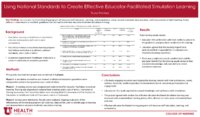 | Using National Standards to Create Effective Educator-Facilitated Simulation Learning | Postma, Trudy W. | 2024 | POSTER |
| 43 |
 | Using National Standards to Create Effective Educator-Facilitated Simulation Learning; Evidence-Based Nursing | Postma, Trudy W. | 2024 | This project highlights the importance of evidence-based simulation learning in healthcare education. Healthcare institutions benefit from uniformity in simulation practices across departments and educators. This project aims to develop an education program for institutional educators in a large aca... |
| 44 |
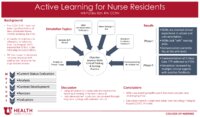 | Active Learning for Nurse Residents | Patzke, William L. | 2023 | POSTER |
| 45 |
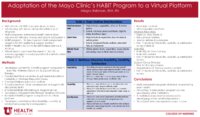 | Adaptation of the Mayo Clinic's HABIT Program to a Virtual Platform | Robinson, Allegra | 2021 | POSTER |
| 46 |
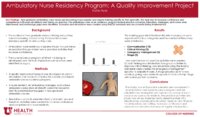 | Ambulatory Nurse Residency Program at the University of Utah Health: A Quality Improvement Project | Huie, Katie | 2023 | POSTER |
| 47 |
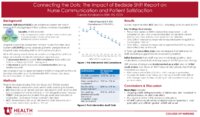 | Connecting the Dots: The Impact of Bedside Shift Report on Nurse Communication and Patient Satisfaction | Kotobalavu, Cassidy | 2021 | POSTER |
| 48 |
 | Health Care Liaison Role for Utah Juvenile Justice System | Bradford, Kathleen | 2021 | POSTER |
| 49 |
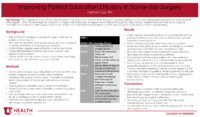 | Improving Patient Education Efficacy in Same-day Surgery | Cox, Hannah | 2021 | POSTER |
| 50 |
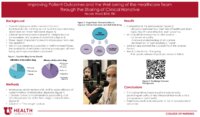 | Improving Patient Outcomes and the Well-being of the Healthcare Team Through the Sharing of Clinical Narrative | Ward, Nicole | 2021 | POSTER |
